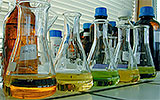Hazardous Substances
Hazardous substances can harm ecosystems and human health. Due to their intrinsic properties, they can accumulate in the food web up to levels that are toxic to organisms, especially higher predators. Hazardous substances can remain in the environment for a very long time.
Did you know?
Cadmium, lead, mercury, DDT, lindane and atrazine are considered to be the most serious polluting chemical substances in the Danube River Basin.
What are hazardous substances?
Hazardous substances are substances that are toxic, persistent and liable to bioaccumulate, or otherwise give reason for concern - by influencing the hormone or immune systems of animals, for example.
Although monitoring indicates that the loads of some hazardous substances have been reduced considerably in recent years, many problems still persist. There is still relatively little comprehensive information about the overall impact of most chemicals available on the market, particularly concerning the effects of combinations of chemicals on human health and the environment. The increasing number of man-made substances present in the environment is a matter of great concern, and calls for the application of the precautionary principle.
The list of priority substances comprises heavy metals and organic substances.
Heavy metals
The Joint Danube Survey in 2001 revealed serious contamination of the Danube and several of its tributaries by heavy metals, including copper and nickel.
The tributaries with the highest excess heavy metal concentrations included the Rusenski Lom, the Iskar and the Timok.
Concentrations of lead, copper and cadmium in the Danube itself are fairly high. About half of all water samples exhibit concentrations exceeding the German target limits. Increased cadmium concentrations were observed in the lower part of the river Danube. In the Danube’s tributaries the situation is slightly better.
Graphic "Cadmium in the Danube"
Eight heavy metals are regularly analysed within the TransNational Monitoring Network (TNMN). These are arsenic, copper, chromium, zinc, cadmium, lead, mercury and nickel, which are priority substances for the Danube River Basin. Cadmium, lead, mercury and nickel are also included in the list of Priority Substances in Annex X of the EU Water Framework Directive.
Organic hazardous substances
Pollution loads of hazardous substances are significant although the full extent cannot be evaluated to date. Currently, there are only few data available for hazardous substances such as pesticides.
p,p’-DDT is a substance of special concern in the lower Danube. Here the very low TNMN target values are often exceeded in the order of two magnitudes. This means that despite a high analytical uncertainty the level of p,p’-DDT is significant and gives a strong indication of potential risk of failure to reach the good status as defined by the EU Water Framework Directive.
For Lindane the results of the TNMN classification are not so alarming. It is however, foreseen that the environmental quality standard that will be set by the EU may be substantially lower than the TNMN target value. In this case, the risk of failure to reach the good status will be much higher and the situation will be similar to that for p,p’-DDT. Some tributaries (Sió, Sajó and Sava) show random occurrence of high concentrations of Atrazine. The elevated concentration of Atrazine in the Sava triggered an alarm in the ICPDR Accident Emergency Warning System in 2003.
During the Joint Danube Survey significant concentrations of the EU WFD priority substances 4-iso-nonylphenol and di[2-ethyl-hexyl]phthalate were found in the bottom sediments as well as in suspended solids. The values ranged from a few µg/kg up to more than 100 mg/kg, indicating the relevance of these compounds as an indicator of industrial pollution in the Danube River.
Disclaimer
The information contained in the ICPDR website is intended to enhance public access to information about the ICPDR and the Danube River. The information is correct to the best of the knowledge of the ICPDR Secretariat. If errors are brought to our attention we will try to correct them.
The ICPDR, expert group members, nor other parties involved in preparation of information contained on this website cannot, however, be held responsible for the correctness and validity of the data and information provided, nor accept responsibility or liability for damages or losses arising directly or indirectly from the use of the information conveyed therein.
Only those documents clearly marked ICPDR documents reflect the position of the ICPDR.
Any links to other websites are provided for your convenience only. The ICPDR does not accept any responsibility for the accuracy, availability, or appropriateness to the user's purposes, of any information or services on any other website.
When using the information and material provided on this website, credit should be given to the ICPDR.

